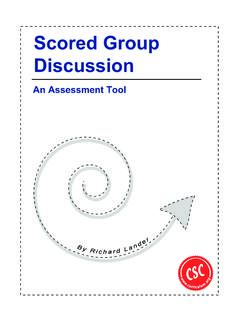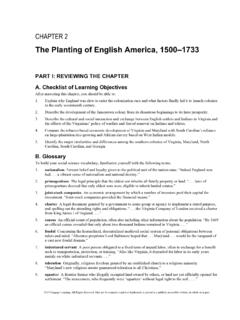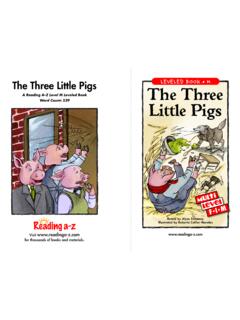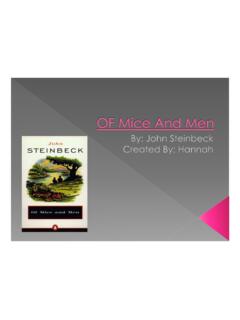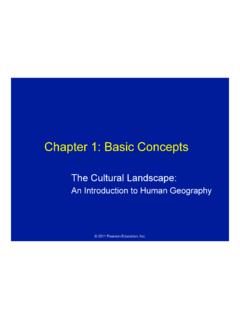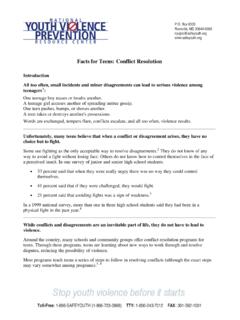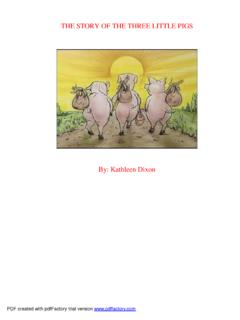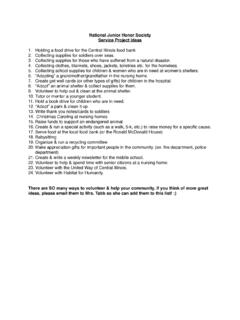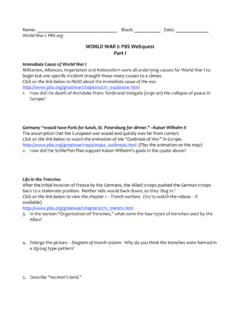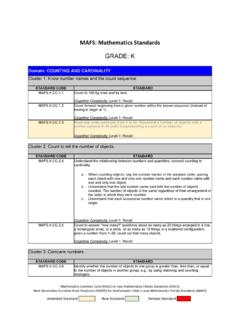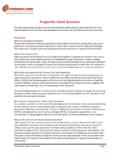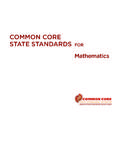Transcription of The First 20 Days: Common Core Edition
1 2013 International Reading Association1 THE First 20 days : Common core Edition August 2013 2 2013 International Reading Association013 International Reading Association11 THE First 20 days : Common core EDITIONTHE First 20 days : Common core Edition August 2013 August 2013 ENGAGING THE ADOLESCENT LEARNERBY DOUGLAS FISHER AND NANCY FREYSSENTIALS IRAThe First 20 DaysCommon core 2013 International Reading 2013 International Reading Association2 THE First 20 days : Common core Edition August 2013 This question has been posed innumerable times as the Common core State Standards for English Language Arts (CCSS; National Governors Association Center for Best Practices [NGA Center] & Council of Chief State School Officers [CCSSO], 2010) move from theoretical construct to reality. Even in regions within and outside of the United States that have not adopted these standards, the CCSS for English Language Arts have become the 800-pound gorilla in the room, dominating nearly every professional conversation.
2 Whether the question is asked of colleagues or is directed inward, there is little doubt that the dilemma of where to begin is of central New Demands A sea change is upon us. The release of the Smarter Balanced Assessment Consortium s practice tests and performance tasks in May 2013 are shaping our understanding of what students will be expected to know and be able to do. For example, the seventh-grade practice test includes an item that asks students to select all the sentences that support a stated concept (item 5). Students reread a 14-sentence passage to determine the answer. The sheer number of possible combinations is mind boggling, and the likelihood of guessing the correct one is near zero. Either one knows the answer, or one doesn t. For students who have grown accustomed to locating one correct answer from four or five choices, this is a daunting the same test, students listen to a four-minute audio presentation about bats (no text) and then answer several multiple-choice and constructed-response questions (items 12 15).
3 Although the audio can be replayed, students are not able to look at a written transcript of the recording. How will students learn the skills needed to answer such questions? How often do students confront such a task in their classes?We return to the question that opens this article: Where to begin? To be sure, the habit of regularly using the critical thinking skills required by the CCSS means that we will need to change our practices accordingly. Questions and tasks that rarely require students to dive below the surface of a text are no longer sufficient. At the same time, secondary students are arriving at our classroom doors with the expectation that it s business as usual. It s not. Chinese philosopher Lao Tzu s reminder that the completion of a long journey begins with the First step is as timely today as it was 2,500 years ago. In this article, we describe a 20-day calendar for getting started with CCSS goals in all else, the CCSS require students to construct knowledge within and across disciplines.
4 Text is at the center, but deep understanding comes by way of extended discussion, research, and writing. This is a marked change from the way many learners have acquired knowledge: the lecture. Students think, The teacher will tell me the content I just need to listen and take is unlikely, however, that high school history students will be able to evaluate authors differing points of view on the same historical event or issue by assessing the authors claims, reasoning, and evidence ( ) without contextualizing these within a time period, participating in debate of the issues, and knowing the structure of argumentation writing. As well, middle school science students need regular opportunities to write if they are to develop and strengthen writing as needed by planning, revising, editing, rewriting, or trying a new approach ( ). Establishing routines, procedures, and expectations within the First 20 days of the school year is critical if students are going to learn at the increased levels demanded by the First Month of SchoolAlthough the domains of reading, writing, speaking and listening, and language are organized in a linear fashion in the CCSS for English Language Arts, in practice they require an integrated and interleaved approach.
5 The First month of school consists of about 20 instructional days that serve as students gateway to the disciplinary knowledge they are expected to learn. These First weeks of school are a critical period in the lives of teachers, too: We encounter and assess students, establish habits of mind and of procedure, and build a community from a group of strangers. Students learn about us as well. Where do I even begin? 2013 International Reading Association3 THE First 20 days : Common core Edition August 2013 Day 2: Listening Across the DivideBarrier games force students to rely on their listening comprehension skills to glean information. Structure a task for your students to complete that is consistent with your discipline ( , assemble a salt molecule using molecular model kits in Chemistry, plot a route on an ancient map in World History, or describe a vocabulary term in English, Password-style).
6 Create a barrier for each student so that he or she cannot see what the other student is doing ( , sitting back to back in their chairs, propping a binder between them). This may be done First as a fishbowl, with a pair of student volunteers who work through a problem together while others observe. After students have completed the activity, debrief with them and make connections to your content. For instance, English teacher Kate Woodbury distributed pairs of slightly different visual scenes to her sixth-grade students and asked them to determine the differences between the two. They discovered they had to be systematic, explicit, and patient, she said. All the traits they ll need to be successful in this class! Day 3: Getting the Gist of a TextSelect a text appropriate to the content and worthy of discussion over the course of several lessons. Middle school science teacher Roberto Pi a chose an article on the science of generating electricity, as designed by William Kamkwamba.
7 As a 14-year-old, he figured out how to construct a windmill using found parts so that his family in Malawi would have electricity, Mr. Pi a said. After students read the article First on their own, Mr. Pi a modeled and thought aloud for his students about how he gained a general understanding of the text. He showed students how he used the title and subheadings over an entire school career. The calendar is color coded to represent the four domains of the CCSS, but in many cases they entail more than one modality. These spotlight lessons are not designed to consume the entire class period and are generally completed in 20 30 minutes, leaving time to attend to other aspects of the First Week of School: Community Building and AssessmentWhile the First week is filled with the clerical tasks of firming up rosters, reviewing the course syllabus, and assigning textbooks, content teaching is also occurring.
8 These spotlight lessons give you the opportunity to establish a classroom culture, gather informal literacy assessment data, and introduce a related 1: Links in a ChainMany teachers begin the school year with an activity that gets students talking about themselves. This is also an ideal time to gather some informal assessment information about each learner. How does he or she make use of vocabulary? What grammatical structures does he or she use while conversing? Who is loud and boisterous? Who is quiet and subdued? Distribute four or five strips of colored paper and ask students to write their names on each, as well as a talent, skill, or interest, while you do the same. Model how you use the strips to support your introduction of yourself and link the strips together to form a paper chain. Each student does the same, creating a long chain that serves as a metaphor for the classroom community you are building.
9 Be sure to take notes about each student so you can use this information in future try to ascertain if we will be flexible or rigid, formal or laid back. Your lessons indicate to students what is important to you. In other words, this is the perfect time to signal to them that how and what they learn will be different from their previous years of the CalendarWe have developed a calendar of literacy lesson topics for the First 20 days of the school year (see Figure). The content of your discipline drives your curriculum, while the literacies used provide the tools for building knowledge. Therefore, the calendar should be understood as a means to spotlight an aspect of the CCSS for English Language Arts that is dovetailed with your curriculum content. These spotlight lessons are interleaved; that is, they are layered to establish a range of practices about how the content is understood, discussed, and written.
10 Although these topics are introduced on a single day, they are built upon and extended throughout the school year. For example, on Day 8, students are instructed on solving unknown words and phrases, but in reality this complex skill is fostered Speaking and ListeningThe Speaking and Listening standards overlay all the others and represent the chief mode of instruction in classrooms. Students and teachers need to use both in equal measure and with equal emphasis in order to maximize communication after all, they re not called the Speaking and Waiting to Speak Again Standards. 2013 International Reading Association4 THE First 20 days : Common core Edition August 2013 Figure. 20-day plan for introducing the CCSS Note. Speaking and Listening (yellow); Language (green); Writing (blue); Reading (orange)DAY 1 Links in a ChainStudents write name and talents/skills on 4 or 5 paper strips, introduce self.
